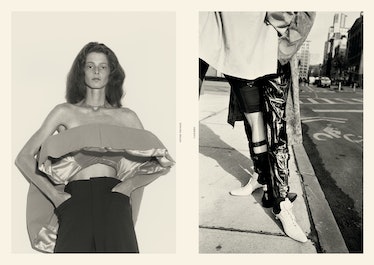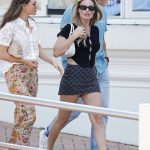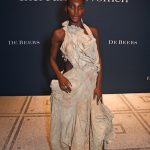When it comes to magazines, those responsible for making the images tend to stay behind the scenes, gracing the pages in name only. But in the latest issue of Study, the French stylist Camille Bidault-Waddington is the star. Editor Christopher Niquet scoured two decades’ worth of photographs from throughout Bidault-Waddington’s career—from shoots with fashion photography titans like Jamie Hawkesworth, Harley Wier, David Sims, Inez & Vinoodh, and many more—to put together a non-traditional portrait of her unique approach to storytelling through clothing. Accompanying the varied images is a short story by the author Natasha Stagg, a dreamy, thought-provoking ramble on the emotional resonance of clothing, and an essay by the writer Wilson Oryema. Ahead of the issue’s release, we chatted with Bidault-Waddington about how her approach has evolved over the years, her own personal fashion passions, and what inspires her as a creative.
What was it like seeing so much of your work—for various outlets and at various stages of your life—put together in this issue of Study?
Christopher, Study’s editor in chief, started with 120 pictures, and then narrowed it down to 60 or 70. Then he came to my house and laid everything out on the table, and it was very interesting to see it that way. Of course, you know you have your own special vision and a taste, or that you’re attracted to certain things unconsciously, but it was really funny to see that I repeated certain (motifs) through the years. I was like, “Oh, it’s what I do. It’s my world.” It’s hard to know your world when you are in it all the time. And as a stylist, it’s not so visible, because you’re working with other people’s creations and lots of different photographers. But seeing everything laid out helped me to work even on the future of developing who I am.
Was there anything that surprised you about the images themselves?
I don’t think I really ever put the clothes on the model properly—the jackets were half worn, or I added a knot or layers for extra volume. The clothes always have some kind of life, or they interact with the other pieces in an interesting way. I realized that it’s a lot about the movement of the clothes more than the clothes themselves.
Has your approach to styling changed significantly since the beginning of your career?
No, I’ve always been drawn to the same things: old Vivienne Westwood stuff, the ’80s new wave, mushroom colors. I like things that are not so easy to understand. I’m still inspired by art, by photography, by books, less by the streets, less by what’s trendy. One thing that has changed is that sometimes styling feels more like problem solving. Sometimes you have to shoot 10 designers who have not a lot in common. You have to find a way to connect them for it to be a story that means something.
Is there anything important about being a stylist that most people wouldn’t know, or that most people don’t understand?
It’s not just about the clothes and the fashion. It’s also about developing a character for the story and working with the photographer to actually express something. And it can be very technical—it’s not just “Ooh it’s great, it’s fashion!” Sometimes it’s also, “We have to shoot that look, even if we don’t want to. How do we do it well?” But you can find beauty in anything, more or less.
What is inspiring you these days?
I love old art books, because they have specific colors and weird subjects that we don’t find so much anymore. Now, when I look at some new photo books, they’re all a bit the same. They always have a close-up of a part of the body, then there is a landscape, then there is a building, then there is some food. But in the old books they were more precise about one world.
How would you describe your approach to getting dressed yourself, compared to your approach to styling professionally?
They’re not related at all anymore. When I was younger, let’s say, I think I would’ve worn some of the looks I was creating. Now, it’s more practical. I’m more grown up.
How would you describe your personal style these days?
I’m more boyish. I don’t wear heels, skirts, or dresses anymore, and I have short hair. When I see old pictures of me, I’m like, “Who is that person?” I was not interested in elegance at all at the beginning. I was more into cool and weird. Although yesterday, I bought some fluorescent yellow trousers, so I wouldn’t say it’s more neutral—I still like something that is bonkers, but that you can wear in a chic way.
Have you always been interested in fashion?
My mother was always buying lots of magazines, so I was always reading them as a kid. Then I went to art school, and suddenly was kind of bored, so I switched to fashion school. From the beginning, I was not into being a designer, and I wasn’t that interested in the clothes. I was more obsessed with art direction and images and photography.
What was your style like as a teenager?
I come from a conservative family. When I turned 14, my father said, “I’ll just give you money and you can get your own clothes.” That lasted three months, because he hated that I was buying bright green suits and zebra-print hats. I was 17 when I started art school, and that’s when I could really start to express myself. I started chopping up dresses to make tops and stuff like that. But France is not the same as London or New York—it’s a bit lame when it comes to street style.
In terms of things generally being more traditional?
Yeah, a bit more classical, and if you were dressed differently, everyone would comment in the street. So it was really a pain in the ass to look different. I had pink hair for three months in the Nineties and it was so annoying. Now everyone has pink hair, but 15-20 years ago, it was not so easy in France to have a strong look.
What was your first major fashion purchase?
When I was modeling for Margiela, we were paid in clothes. I had some really, really cool Margiela stuff. One is a sweater made out of old army socks. It’s very itchy, but it’s beautiful. I never really bought super expensive stuff. When you work in fashion, sometimes it feels weird. By the time things are in the shops, you don’t want them anymore.
What’s the most prized possession in your closet?
I have a nice dress by Nicolas Ghesquière when he was at Balenciaga. It’s short with big eyelets and color blocks. It looks like a huge shoe, because the eyelets look like the shoelace holes at the top of a sneaker. That and a pair of Balenciaga shoes made with so many different textures that they’re a technical performance. There’s something totally insane about them. They’re like a museum piece.
Do you have any favorite places to shop these days?
I mostly buy vintage. I don’t like bright, new things. I like things that have been worn already, and when colors are faded or bleached by the sun. And I still buy things from John Galliano’s Margiela. I like when it’s sentimental.
Is there anyone whose style you particularly admire?
Lizzi Bougatsos from the band Gang Gang Dance. And the women who were in Malaria, which was a German band in the ’80s.
Do you have any fashion regrets?
Yeah, I wish I had more stupid haircuts.
I feel like people usually give the opposite answer. It’s the haircuts they regret!
But I wish I had those regrets—I wish I had been more extreme in my mistakes!



